Have you ever spotted these tiny, uninvited guests scurrying around your cat’s litter box? Not only do they make the litter box an unappealing spot for your furry friend, but they can also be a nuisance in your home.
So, how to get rid of bugs in cat litter?
It’s vital to address the issue promptly to maintain a clean and healthy environment for both you and your cat.
Identifying the problem is the first step; knowing the telltale signs of a bug infestation can help you tackle the issue head-on.

Bugs in the cat litter can range from harmless to harmful, and understanding the varieties you’re dealing with is crucial.
Some may be attracted to the moisture, while others could be after the waste itself.
Preventing these pests is always easier than getting rid of them, so having a few strategies up your sleeve can make all the difference.
A consistent cleaning routine, proper storage of litter, and knowing when to completely change the litter are all important preventative measures. (1)
Key Takeaways
- Regularly inspect cat litter for signs of bugs to catch infestations early.
- Learn about different types of bugs to effectively target and eliminate them from the litter box.
- Implement prevention strategies to maintain a bug-free and hygienic space for your cat.
How to Get Rid of Bugs in Cat Litter: A Comprehensive Guide
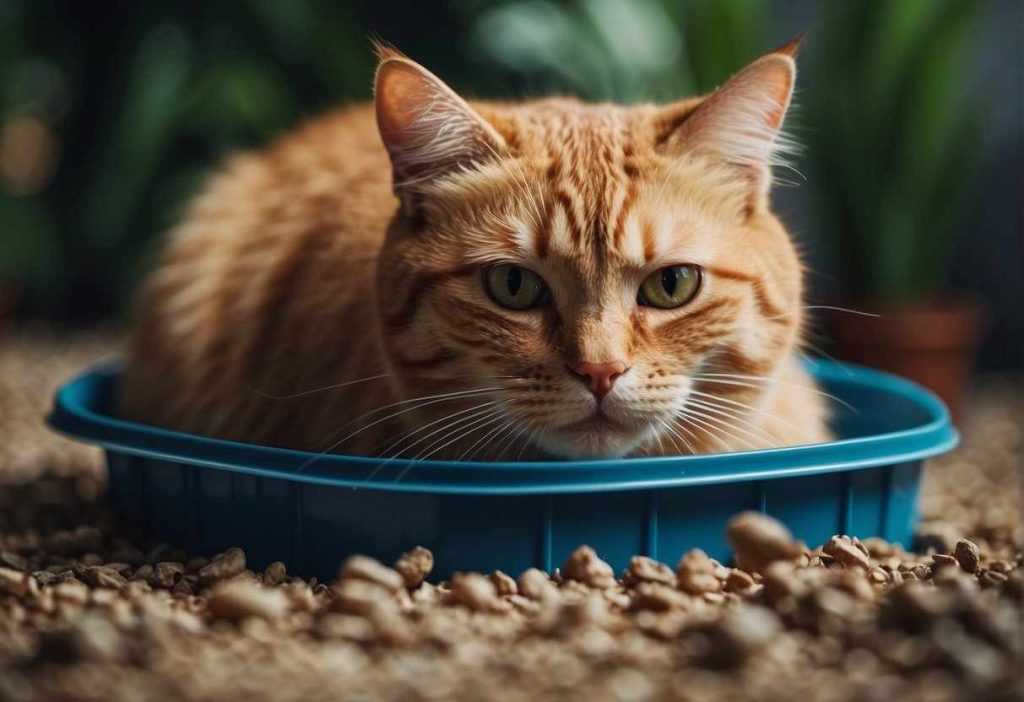
Preparing for Cleanup
Before you dive into combat, suit up! You’ll need:
- Gloves
- Mask
- Sealable plastic bags
- Paper towels or disposable clothes
- Natural disinfectant or a homemade solution (vinegar and water, anyone?) (2)
Remember, personal safety first. Keep that litter dust out of your lungs and off your skin.
Detailed Cleaning Procedures
Let’s break it down, step by step:
- Empty the Box: Carefully scoop all the litter into a sealable bag.
- Wash Thoroughly: Scrub the box with soapy water. Rinse well.
- Disinfect: Wipe with your chosen disinfectant, and don’t rush. Let it sit for a couple of minutes. (3)
- Dry: Air dry the box or use paper towels. Make sure it’s bone-dry to avoid moisture-loving pests.
No videos or visuals here, but imagine giving that litter box a spa day. You’re not just cleaning; you’re pampering!
Fresh bedding lays the groundwork for a bug-free zone.
Sprinkle some food-grade diatomaceous earth on the box’s bottom before adding new litter. It’s like laying down a microscopic bug barricade.
And that’s it! A fortress of feline cleanliness. Keep it tight, keep it right, and those bugs will find themselves out of a home.
Regular cleaning is your new best friend—welcome to the club!
Preventative Strategies to Maintain a Bug-Free Litter Box
Routine Maintenance Practices
Hey, cat parents! Are you tired of uninvited creepy crawlies gatecrashing your kitty’s restroom? Here’s a pro tip: keep that litter box shipshape.
Here’s a handy-dandy chart to help you out:
| Frequency | Task |
|---|---|
| Daily | Scoop the waste. |
| Weekly | Change the litter completely. |
| Monthly | Scrub and sanitize the box. |
Remember, consistency is key to a pest-free litter zone.
Environmental Adjustments
Got bugs? They hate dry and cool places. So, what about turning the tables in your favor by tweaking your home’s environment?
Aim for lower humidity and cooler temperatures around the litter area. Consider a dehumidifier or air conditioner to create a no-bug zone. No sauna parties for pests!
Tools and Methods
Might as well hang up a “Bugs Not Welcome” sign, right? Use pest repellents but ensure they are non-toxic to cats.
Certain plants like lavender can dissuade insects naturally without harming your fluffball. (4)
Strategic Placement of Litter Boxes
Your litter box location can be a real game-changer.
Avoid spots with high traffic and easy outdoor access. Instead, position it in a well-ventilated, low-humidity area away from windows and doors.
It’s like setting up a VIP lounge for your cat—exclusive and bug-free.
Understanding Bugs in Cat Litter
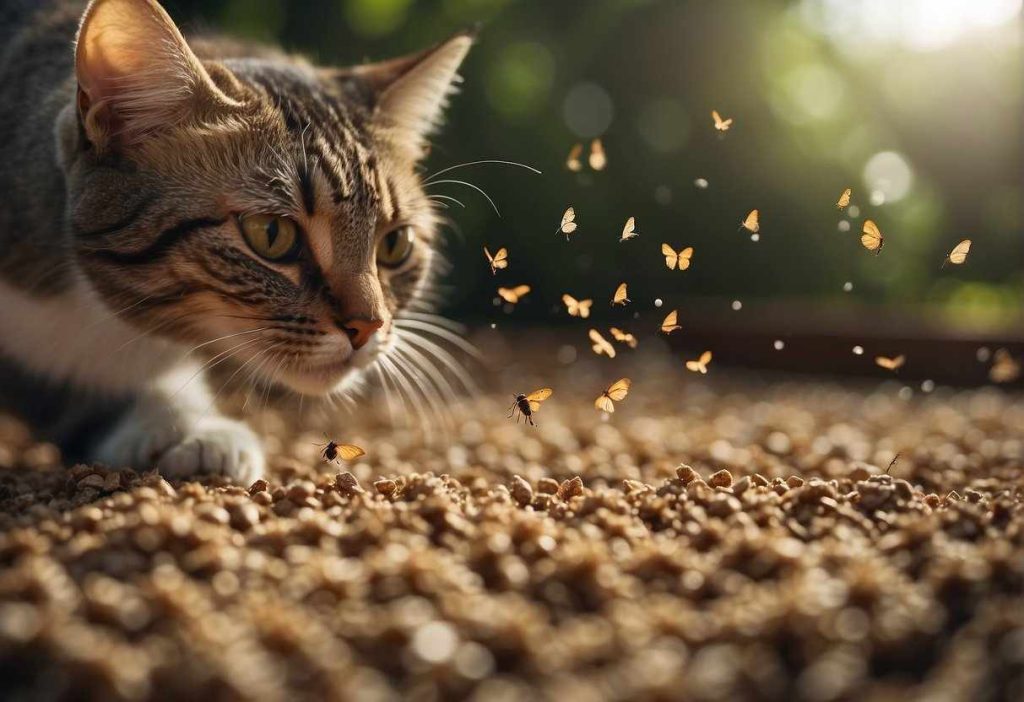
Common Types of Bugs Found in Cat Litter You might find a range of critters in that litter box. Here’s a quick rundown:
- Fruit Flies: Small and brown with red eyes. (5)
- Fungus Gnats: Tiny and black, with long legs. (6)
- Ants: Variable in color and size, but always unwelcome.
Why Bugs Are Attracted to Cat Litter
Curious about what makes these bugs want to set up camp in your cat’s litter? Here’s the scoop:
- Moisture: Bugs love damp areas, and a litter box can be just that. (7)
- Odor: Cat waste emits strong smells that can lure in insects looking for food or a place to lay eggs.
- Trash: If the litter isn’t changed regularly, it becomes a bug banquet.
By understanding the “why” and “what,” you can gear up to kick those bugs to the curb. Your feline will thank you!
Health Implications for Your Cat and Home

When bugs decide to take up residence in your cat’s litter box, it’s not just a nuisance—it’s a health issue. You might ask yourself, what kind of dangers are we looking at here? Here’s the scoop:
- Cats: Your feline friends can suffer from skin irritations and digestive problems if they come into contact with these pests. They may start scratching more than usual, which is a sign that something’s up.
- Human Housemates: You’re not immune either! Some bugs can transmit diseases to humans, especially to those with weakened immune systems.
The bugs aren’t paying rent; time to evict them! Ignoring the problem can lead to:
- Long-term effects: Think respiratory issues from breathing in bug-related allergens and more frequent visits to the vet.
So, how can you keep your home and furry pals safe?
- Regular Litter Cleaning: Scoop daily, replace frequently.
- Storage Matters: Keep litter in a sealed container to prevent bugs from treating it like a buffet.
- Quality Litter Choice: Some litters are more resistant to bugs. Do your research!
The clock’s ticking – the sooner you tackle the creepy crawlies, the better for everyone’s health.
Remember, a little legwork today can keep those pesky bugs away!
Advanced Pest Control Techniques
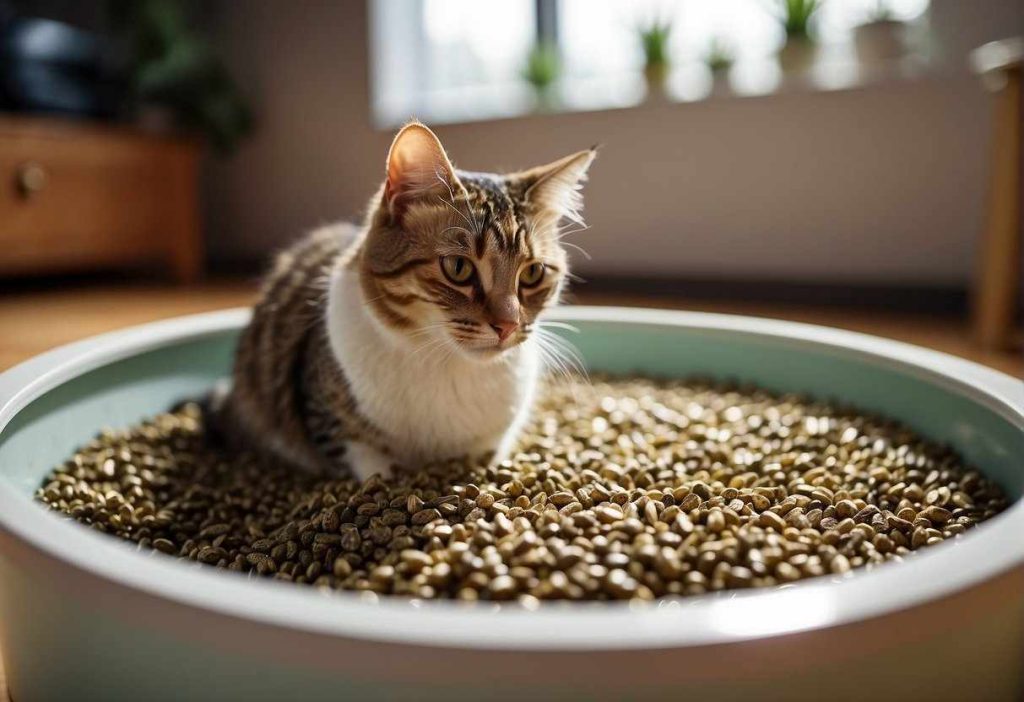
When DIY Isn’t Enough: Seeking Professional Help
Are your DIY efforts just not cutting it? Keep an eye out for these signs:
- Recurring infestations despite regular cleaning
- Large numbers of pests beyond the usual one or two invaders
- Your cat is distressed or avoiding the litter box
If any of these ring true, it might be time to phone a pro. They have the right tools and expertise to tackle stubborn pests effectively.
Eco-Friendly and Safe Pest Control Solutions
Worried about harsh chemicals? Professionals can offer you a range of green options. Here are some you can ask about:
- Boric Acid: Less toxic than many other insecticides and can be used around cats safely.
- Diatomaceous Earth: A natural and non-toxic powder that dehydrates insects without chemical risks.
- Beneficial Nematodes: These little critters are natural parasites to harmful pests but are harmless to pets and humans.
How to Prevent Future Infestations
Post-treatment, stay proactive with these simple steps:
- Keep the litter box clean by scooping daily.
- Change the litter and wash the box regularly.
- Store litter in a sealed container to keep it bug-free.
Remember, a happy cat equals a happy you. So don’t let pests spoil the blissful bond you share with your furry friend.
If the bugs come back, it’s just a signal to switch up your game plan, and sometimes that means bringing in an eco-friendly expert.
Engaging with the Community
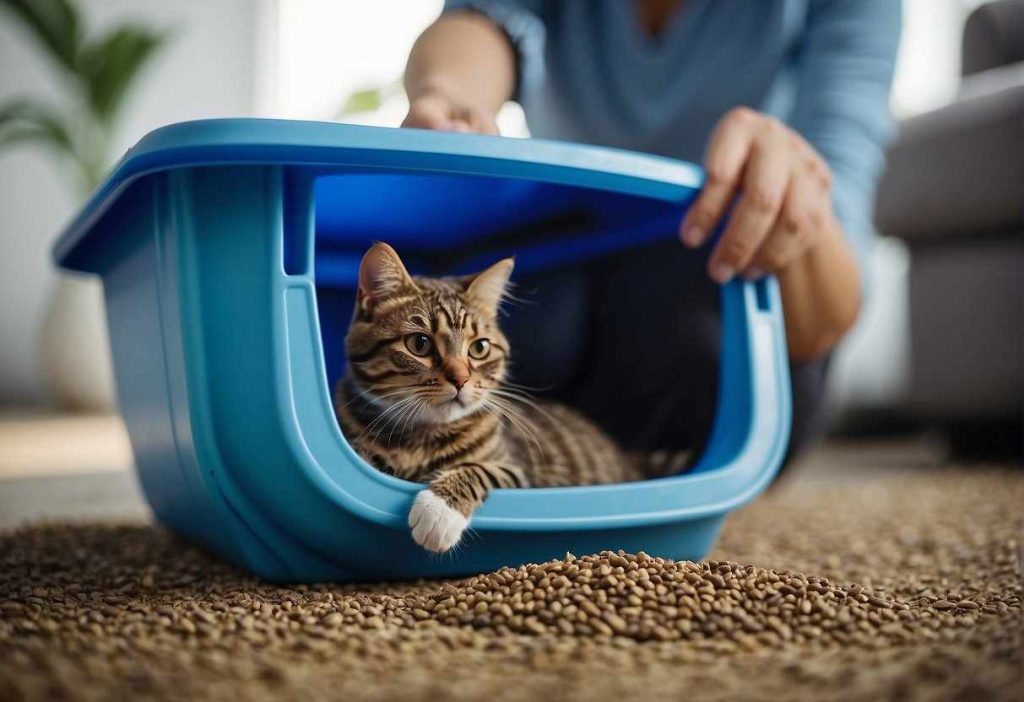
Success Stories and Testimonials
People in your shoes have been where you are—frustrated with unwelcome guests in their cat’s private space. Here’s what they did:
- Mary K. used a diatomaceous earth sprinkle that led to a bug-free zone in just two weeks.
- Jason T. shared that consistent deep cleaning was his game-changer for repelling litter pests.
Recommended Products and Services
Don’t waste hours researching. Below is a community-vetted list to save you time and keep your cat happy:
- Vet-Approved Repellents:
- CritterSafe Litter Additive
- EcoMighty Mite Powder
- Pest Control Services:
- BugsBeGone: Known for eco-friendly treatments.
- WhiskerGuard: They offer specialized feline-friendly services.
A conversation starter could be as simple as, “Has anyone tried a new litter de-bugger?” or “Any natural remedies for these annoying insects?”
Remember, there’s strength in numbers, and your community is a goldmine for practical, tried-and-tested solutions.
And hey, you might even make a new friend or two along the cat-parent journey!
Quick Recap

Let’s go over the high points, so you remember the best ways to keep those bugs at bay!
- Proper Sanitation: Always start with a clean slate. A thorough, regular cleaning of the litter box is a must. Replace the litter, wash the box, and use hot water and soap.
- Litter Choice: Your choice of litter matters. Some options, like non-clumping or natural litters, can be less inviting to bugs.
- Food Sources: Sweep around the area; bugs love those stray bits of cat food that might be lurking around.
- Use of Insecticides: If things get dicey, use pet-safe insecticides. But remember, safety first! Always follow the manufacturer’s instructions.
- Regular Inspections: Stay sharp and keep an eye on the litter box. The sooner you spot a bug, the easier it is to stop an infestation.
- Professional Help: If all else fails, or the problem is severe, don’t hesitate to call the cavalry—aka a professional exterminator.
Remember, you’re the first line of defense in the bug battle.
Your furry friend is counting on you, so keep up the good work and maintain that bug-free zone!
Frequently Asked Questions
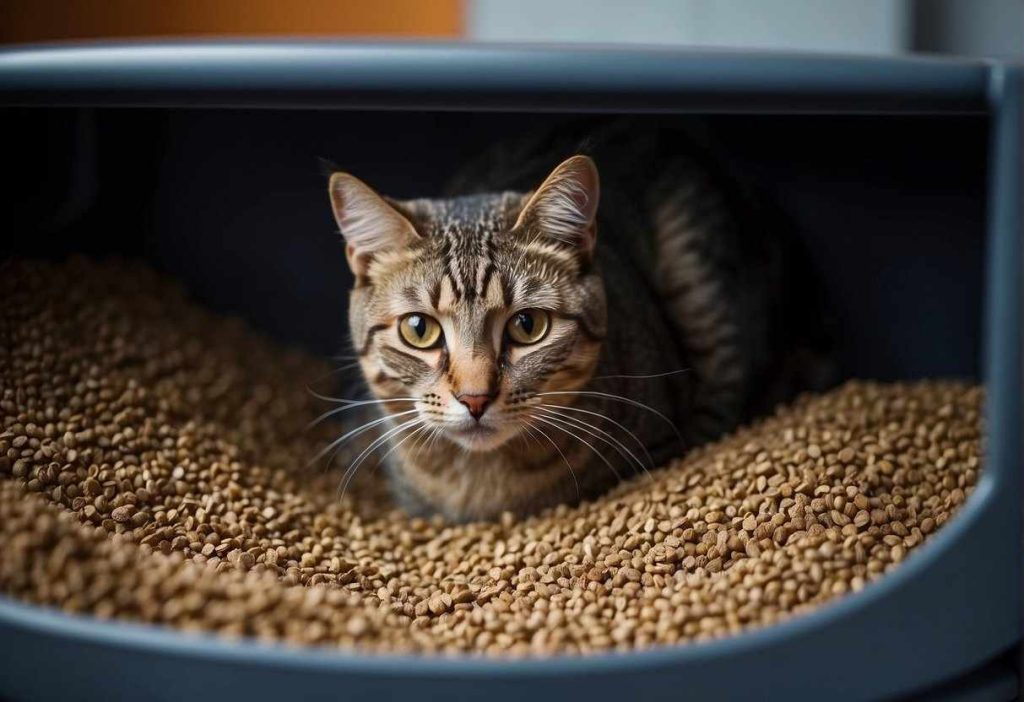
Encountering bugs in your cat’s litter box can be a nuisance, but don’t fret! Here’s a speedy rundown of the common critters and savvy solutions to keep your feline’s facilities spotless.
What are the most common types of bugs found in cat litter?
Typically, you might find grain mites, beetles, or even the occasional fruit fly calling your cat’s litter box home. These critters are attracted to the damp, soiled environment.
How often should I clean the litter box to prevent bug infestations?
To be on the safe side, scoop daily and replace with fresh litter every week. This routine disrupts any bug life cycle and keeps your cat’s area unappealing to pests.
Are there any cat-friendly pesticides or treatments to eliminate litter box bugs?
Sure thing! Non-toxic diatomaceous earth can be sprinkled in the litter as it’s safe for cats and lethal for bugs. Always shy away from harsh chemicals that could harm your furry friend.
Can certain types of cat litter help prevent bug infestations?
Indeed, non-clumping, silica gel-based litters can be less attractive to bugs due to their low moisture levels. Opting for these can keep the critters at bay.
What are the signs of a bug infestation in a cat litter box?
Keep an eye peeled for tiny insects crawling around or larvae. Also, an unusual smell can be a giveaway that unwelcome guests are present.
Is there a way to stop bugs from jumping or flying out of the litter box?
Covered litter boxes or a fine net can act as a simple barrier. Even better, maintaining a spotless box is key to dissuading bugs from setting up camp.
Where should I place my cat’s litter box to reduce the risk of bug infestations?
Place the litter box in a dry, well-ventilated area. Bathrooms or laundries are often the prime real estate to avoid bug-friendly damp habitats.


